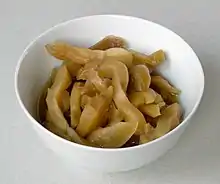Zha cai
Zha cai ([ʈʂâ tsʰâɪ]; 榨菜), also romanized as Cha tsai, is a type of pickled mustard plant stem originating from Chongqing, China. The name may also be written in English as cha tsai, tsa tsai, jar choy, jar choi, ja choi, ja choy, or cha tsoi. In English, it is commonly known as Sichuan vegetable, Szechwan vegetable, or Chinese pickled vegetable, although all of these terms may also refer to any of a number of other Chinese pickles, including the several other types in the Sichuan province itself.[1]
| Zha cai | |||||||||||||||||||||
|---|---|---|---|---|---|---|---|---|---|---|---|---|---|---|---|---|---|---|---|---|---|
 Whole heads of zha cai coated in chili paste | |||||||||||||||||||||
| Chinese | 榨菜 | ||||||||||||||||||||
| Hanyu Pinyin | zhà cài | ||||||||||||||||||||
| |||||||||||||||||||||
Production

The pickle is made from the knobby, fist-sized, swollen green stem of Brassica juncea, subspecies tsatsai. The stem is first salted and pressed, and dried before being rubbed with hot red chili paste and allowed to ferment in an earthenware jar.[2] This preservation process is similar to that used to produce Korean kimchi.
Flavour
The taste is a combination of spicy, sour, and salty. Its unique texture—crunchy, yet tender—can only be vaguely compared to Western pickled cucumbers. Zha cai is generally washed prior to use in order to remove the chili paste. Excess salt in the preserved vegetable is leached out by soaking in fresh water. Considered to be rich in umami, zha cai varies in spiciness depending on the amount of chili paste used in preparation.[3]
Uses

Originating in Sichuan and believed to be one of the world's oldest types of pickles,[4] zha cai is used in many of the various cuisines of China such as in Sichuan dan dan noodles,[5] in soups with ground pork and mifen, and as a condiment for rice congee.[6] It is generally sliced into thin strips and used in small amounts due to its extreme saltiness, although this saltiness can be tempered somewhat by soaking the strips in water prior to use.
A popular Chinese dish featuring zha cai is "noodles with Zha Cai and shredded pork" (榨菜肉絲麵; zhà cài ròusī miàn).[7] Zha cai is also an ingredient of ci fan tuan, a popular dish in Shanghai cuisine.
In Japan, the pickle is common in Chinese restaurants (though it is usually less spicy, to suit Japanese tastes), and it is transliterated into Japanese as zāsai (katakana: ザーサイ; kanji: 搾菜).
Like other vegetable stems in Chinese cuisines, particularly celtuce, zha cai can also be sliced and sautéed.
Manufacturers
Fuling, a district in Chongqing, is closely associated with zha cai.[8] The largest manufacturer, Fuling Zhacai, manufacturers of the Wujiang (乌江, Wu River) brand, is listed on the Shenzhen Stock Exchange[9] and in 2021 celebrated selling 15 billion packets.[10]
See also
- List of pickled foods
- Ya cai
- Meigan cai – Type of dry pickled Chinese mustard
- Pao cai – Pickle in Chinese, and particularly Sichuan cuisine
- Suan cai – Traditional Chinese pickled vegetables
- Tianjin preserved vegetable – Type of pickled Chinese cabbage originating in Tianjin, China
References
- Pictures and more descriptions of zha cai
- "Zha Cai | Local Condiment From Sichuan". TasteAtlas. Archived from the original on 2022-10-24.
- Karen Yuan (2021-09-14). "Dear Pickle People, Zha Cai Should Be Your Favorite Condiment". Bon Appétit. Retrieved 2022-10-24.
- Dr Q.V. Nguyen; Peter Core (September 2000). "Pickled and Dried Asian Vegetables (page vii)" (PDF). AgriFutures Australia. Archived (PDF) from the original on 2022-10-09.
- Katie Workman (2018-01-09). "COOKING ON DEADLINE: Dan Dan Noodles". National Post. Retrieved 2022-10-25.
- Marion, Jane; Cohen, Lauren; Hong, Henry; Unger, Mike; Woolever, Lydia (2019-10-07). "Eat Global (under the GLOBAL PANTRY section)". Baltimore Magazine. Archived from the original on 2022-10-25.
- 航迷老叟 (2021-11-03). "食譜/家常版榨菜肉絲麵 味濃湯美肉絲嫩滑" [Recipe/Home-style mustard and pork noodles]. United Daily News (in Traditional Chinese). Archived from the original on 2021-11-11.
- "The pick of Chinese pickles: Zhacai". 4 May 2014.
- "About Us".
- "15 Billion Packets Sold Globally, China's Wujiang Now World Famous!" (Press release). 27 January 2021.